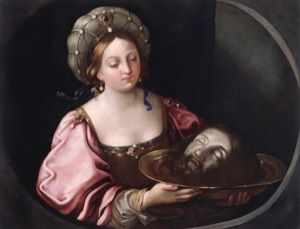
Reni, Guido (possibly after). Salome with the Head of John the Baptiste. 1500-1700. Oil on canvas. 23 in. x 30 in. (58.72 cm. X 76.2 cm.) Bequest of the Honorable James Bowdoin III.
Despite ignoring the violence of a decapitation and the vulgarity of a seductive dancer, Reni’s deliberate understatement of such a scene is nearly just as lewd. Salome has bright blushing cheeks that match the rich, almost moving folds of her silks. She is the definition of life, especially in comparison to the near-blue color and numbness of St. John the Baptist’s bloodless face. His head becomes another object, detached from both his body—a symbol for his holiness as saints do not bleed viscera like regular mortals and for the destruction of ill-behaved women like Salome.
While there is uncertainty regarding the exact date and origin of the painting, it is in step with it’s Renaissance contemporaries in it’s representation of Salome as an Eve-like courtly lady. Rather suggestively, it bears striking resemblance via nonchalant but presenting pose, bespoke and turbaned attire, and physical likeness to Salome with the Head of John the Baptist by Circle of Guido Reni. While the attempt of Renaissance artists to erase Salome’s canonical sexuality by transforming the dancer into a courtly lady, they only succeed in sublimating it. This is, in part, because at the time, the rise of the merchant class saw a flood of instructional content—everything from explicit instruction manuals to didactic literature. Art becomes a method of both inducing and signaling moral, (and often gendered) virtues. In understating her sexuality, the artists reinforce the idea that female sexuality is so unspeakable that the decapitated head of a saint is more appropriate for viewing. Salome is a warning sign, warding off women from temptation and returning their focus to their own modesty.
Sources:
Jordan, William Chester. “Salome in the Middle Ages.” Jewish History, vol. 26, no. 1/2, 2012, pp. 5–15.
Karasick, Adeena. “Salomé: Woman of Valor.” Nashim: A Journal of Jewish Women’s Studies & Gender Issues, no. 26, 2014, pp. 147–57. JSTOR, doi:10.2979/nashim.26.147.
Kultermann, Udo. “The ‘Dance of the Seven Veils’. Salome and Erotic Culture around 1900.” Artibus et Historiae, vol. 27, no. 53, 2006, pp. 187–215. JSTOR, doi:10.2307/20067116.
Long, Jane C. “Dangerous Women: Observations on the Feast of Herod in Florentine Art of the Early Renaissance.” Renaissance Quarterly, vol. 66, no. 4, 2013, pp. 1153–205. JSTOR, doi:10.1086/675090.
Reni, Guido Salome ||| Old Master Paintings ||| Sotheby’s L10035lot5tq8zen. https://www.sothebys.com/en/auctions/ecatalogue/lot.92.html/2010/old-master-and-british-paintings-l10035. Accessed 21 Dec. 2020.
Rodney, Nanette B. “Salome.” The Metropolitan Museum of Art Bulletin, vol. 11, no. 7, 1953, pp. 190–200. JSTOR, doi:10.2307/3257597.